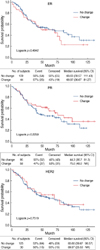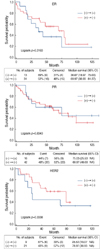Abstract
Purpose
This study aimed at evaluating the pattern of changes in estrogen receptor (ER), progesterone receptor (PR) and the HER2 expression in primary and recurrent breast cancer.
Methods
In the study, we analyzed the changes of the ER and PR and the HER2 immunohistochemical expression to identify the patterns of changes and the predictive factors for the changes in 153 patients with primary and recurrent breast cancer between 1991 and 2005.
Results
There was a significant decrease in the positive rate of ER (50.3% to 38.6%, p<0.001), PR (43.8% to 26.8%, p=0.0095) and the HER2 (40.3% to 36.3%, p<0.001) expression in the primary breast cancers and recurrent breast cancers. The rate of triple negativity (ER/PR/HER2: all negative) was increased from 25.8% to 43.5% (p<0.001). Among 44 (28.6%) patients with changes in ER and ER status changed from positive to negative in 31 patients (20.3%) and negative to positive in 13 patients (8.3%) (p=0.007). For 58 patients (37.9%) who showed a change of the PR, the PR status changed from positive to negative in 42 patients (27.5%) and vice versa in 16 patients (10.4%) (p=0.0006). Twenty one patients (16.9%) changed from HER2 positive to HER2 negative and vice versa in 9 patients (7.3%) (p=0.029) among the 30 patients (24.2%) with changes in the HER2 expression. A multivariate analysis indicated that hormonal therapy was a significant factor that had an influence on the ER (odds ratio, 4.4) and PR (odds ratio, 2.6) changes. There were no significant differences in the survival rates according to the changes of the ER and PR, and the HER2 expression.
Conclusion
The more common changes from positive to negative among the ER, PR, and HER2 indicated poor tumor biology of recurrent tumor. Therefore, the assessment of the ER, PR, and HER2 statuses is important for effectively treating recurrent breast cancer and especially those who have a previous history of hormonal therapy although survival benefit was not observed in this study.
Figures and Tables
 | Figure 1Survival curve of patient according to change of hormone receptor and HER2 expression in primary and recurrent breast cancer. |
 | Figure 2Survival curve of patient according to change pattern of hormone receptor and HER2 expression in primary and recurrent breast cancer. |
Table 2
Positivity of ER, PR, HER2 overexpression and triple negativity in primary and recurrent breast cancers

References
1. Kim SY, Noh DY, RO JY, Park KM, Park BW, Bae JW, et al. The Korean Breast Cancer Society. Prognostic and predictive factors. The Breast. 2005. 2th ed. Seoul: Ilchokak;357–366.
2. Fisher B, Jeong JH, Bryant J, Anderson S, Dignam J, Fisher ER, et al. Treatment of lymph-node-negative, estrogen-receptor-positive breast cancer: long-term findings from National Surgical Adjuvant Breast and Bowel Project randomized clinical trials. Lancet. 2004. 364:858–868.

4. Shimizu C, Fukutomi T, Tsuda H, Akashi-Tanaka S, Watanabe T, Nanasawa T, et al. C-erbB-2 protein overexpression and p53 immunoreaction in primary and recurrent breast cancer tissues. J Surg Oncol. 2000. 73:17–20.

5. Knight WA, Livingston RB, Gregory EJ, McGuire WL. Estrogen receptor as an independent prognostic factor for early recurrence in breast cancer. Cancer Res. 1977. 37:4669–4671.
6. Lee JW, Han W, Ko E, Cho J, Jung SY, Kim EK, et al. Alteration of estrogen receptor, progesterone receptor, and HER2 expression in breast cancer after neoadjuvant chemotherapy. J Breast Cancer. 2007. 10:206–210.

7. Allred DC, Harvey JM, Berardo M, Clark GM. Prognostic and predictive factors in breast cancer by immunohistochemical analysis. Mod Pathol. 1998. 11:155–168.




 PDF
PDF ePub
ePub Citation
Citation Print
Print







 XML Download
XML Download